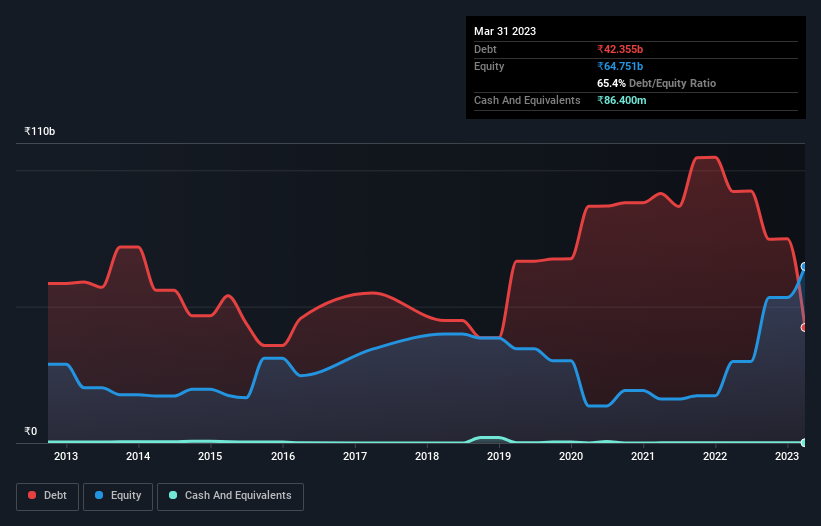- India
- /
- Oil and Gas
- /
- NSEI:CHENNPETRO
These 4 Measures Indicate That Chennai Petroleum (NSE:CHENNPETRO) Is Using Debt Reasonably Well

Legendary fund manager Li Lu (who Charlie Munger backed) once said, 'The biggest investment risk is not the volatility of prices, but whether you will suffer a permanent loss of capital.' So it seems the smart money knows that debt - which is usually involved in bankruptcies - is a very important factor, when you assess how risky a company is. As with many other companies Chennai Petroleum Corporation Limited (NSE:CHENNPETRO) makes use of debt. But is this debt a concern to shareholders?
When Is Debt Dangerous?
Debt assists a business until the business has trouble paying it off, either with new capital or with free cash flow. Ultimately, if the company can't fulfill its legal obligations to repay debt, shareholders could walk away with nothing. However, a more usual (but still expensive) situation is where a company must dilute shareholders at a cheap share price simply to get debt under control. Of course, plenty of companies use debt to fund growth, without any negative consequences. The first thing to do when considering how much debt a business uses is to look at its cash and debt together.
See our latest analysis for Chennai Petroleum
What Is Chennai Petroleum's Net Debt?
The image below, which you can click on for greater detail, shows that Chennai Petroleum had debt of ₹42.4b at the end of March 2023, a reduction from ₹92.2b over a year. Net debt is about the same, since the it doesn't have much cash.

How Strong Is Chennai Petroleum's Balance Sheet?
According to the last reported balance sheet, Chennai Petroleum had liabilities of ₹65.8b due within 12 months, and liabilities of ₹29.8b due beyond 12 months. On the other hand, it had cash of ₹86.4m and ₹3.12b worth of receivables due within a year. So its liabilities outweigh the sum of its cash and (near-term) receivables by ₹92.4b.
Given this deficit is actually higher than the company's market capitalization of ₹63.7b, we think shareholders really should watch Chennai Petroleum's debt levels, like a parent watching their child ride a bike for the first time. In the scenario where the company had to clean up its balance sheet quickly, it seems likely shareholders would suffer extensive dilution.
We measure a company's debt load relative to its earnings power by looking at its net debt divided by its earnings before interest, tax, depreciation, and amortization (EBITDA) and by calculating how easily its earnings before interest and tax (EBIT) cover its interest expense (interest cover). The advantage of this approach is that we take into account both the absolute quantum of debt (with net debt to EBITDA) and the actual interest expenses associated with that debt (with its interest cover ratio).
Chennai Petroleum has a low net debt to EBITDA ratio of only 0.74. And its EBIT easily covers its interest expense, being 15.5 times the size. So we're pretty relaxed about its super-conservative use of debt. Better yet, Chennai Petroleum grew its EBIT by 120% last year, which is an impressive improvement. That boost will make it even easier to pay down debt going forward. When analysing debt levels, the balance sheet is the obvious place to start. But ultimately the future profitability of the business will decide if Chennai Petroleum can strengthen its balance sheet over time. So if you're focused on the future you can check out this free report showing analyst profit forecasts.
Finally, while the tax-man may adore accounting profits, lenders only accept cold hard cash. So we always check how much of that EBIT is translated into free cash flow. During the last three years, Chennai Petroleum produced sturdy free cash flow equating to 61% of its EBIT, about what we'd expect. This cold hard cash means it can reduce its debt when it wants to.
Our View
Chennai Petroleum's interest cover was a real positive on this analysis, as was its EBIT growth rate. In contrast, our confidence was undermined by its apparent struggle to handle its total liabilities. When we consider all the elements mentioned above, it seems to us that Chennai Petroleum is managing its debt quite well. Having said that, the load is sufficiently heavy that we would recommend any shareholders keep a close eye on it. When analysing debt levels, the balance sheet is the obvious place to start. However, not all investment risk resides within the balance sheet - far from it. Be aware that Chennai Petroleum is showing 3 warning signs in our investment analysis , and 1 of those can't be ignored...
If you're interested in investing in businesses that can grow profits without the burden of debt, then check out this free list of growing businesses that have net cash on the balance sheet.
New: AI Stock Screener & Alerts
Our new AI Stock Screener scans the market every day to uncover opportunities.
• Dividend Powerhouses (3%+ Yield)
• Undervalued Small Caps with Insider Buying
• High growth Tech and AI Companies
Or build your own from over 50 metrics.
Have feedback on this article? Concerned about the content? Get in touch with us directly. Alternatively, email editorial-team (at) simplywallst.com.
This article by Simply Wall St is general in nature. We provide commentary based on historical data and analyst forecasts only using an unbiased methodology and our articles are not intended to be financial advice. It does not constitute a recommendation to buy or sell any stock, and does not take account of your objectives, or your financial situation. We aim to bring you long-term focused analysis driven by fundamental data. Note that our analysis may not factor in the latest price-sensitive company announcements or qualitative material. Simply Wall St has no position in any stocks mentioned.
About NSEI:CHENNPETRO
Excellent balance sheet with moderate growth potential.
Market Insights
Community Narratives




